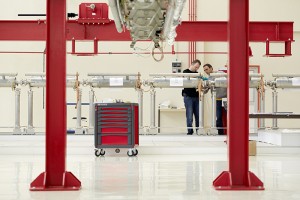While not quite having the poetical resonance of April, nevertheless November in the French capital has many charms. Researchers from all over the world experienced these last week. From Wednesday to Friday, more than 80 people met at Saclay to discuss R&D efforts for both the ILC detectors and the accelerator. The “Irfu Linear Collider Days”, expertly organised by Maxim Titov and his committee, concentrated on French activities and plans for the first two days, opening up to the rest of the world on Friday.
On Friday morning, head of CEA-Irfu Philippe Chomaz welcomed delegates from France, Germany, Italy, Japan, Norway, Spain, UK and the US. Marc Winter stood in for CNRS/IN2P3 director Jacques Martino, who was in Poland, and reiterated this welcome and the importance that the ILC has in the French Roadmap for particle physics. During the morning, the large countries reported on activities in both machine and detectors. During the lunch break Eckhard Elsen from DESY and I were treated to a private tour of the European XFEL cryomodule construction “village” on the Saclay site. With Olivier Napoly as our expert guide, we were able to see for ourselves the impressive facility that has been constructed from the buildings of a nuclear physics facility. Our group at DESY has been involved in the characterisation of the cavities that are here built into cryomodules, so it was fascinating to see the complex procedure that is already producing modules with fantastic performance. While not yet fully in production mode, the Saclay assembly line has already produced a module whose performance exceeds that required for ILC, a remarkable achievement considering that the specification for the cavities and cryomodules for XFEL is much less than required for ILC.
On Friday afternoon the meeting relocated to LAL in Orsay, just down the road from Saclay, for a smaller meeting organised by me, as European Director of the LCC, and Juan Fuster, the Chair of the ECFA study on the physics and detectors for a linear collider. The purpose of the meeting was to discuss the possibilities for obtaining funding for ILC-related activities from the new European scientific-funding framework, Horizon 2020 (H2020), which takes over next year from the current scheme Framework 7 (FP7). Having been successful in several projects in FP7, it is important to understand the new framework for European funding and how to maximise our chances of success. We were very grateful that Svet Stavrev, head of CERN’s European Projects Office, could give us a comprehensive introduction to the H2020 programme and also give us some recommendations of what seemed to be the most suitable thematic areas towards which we should tailor our applications. Around 30 people drawn from the main meeting listened to Svet and to a subsequent sequence of talks illustrating the main areas of activity going on inside Europe.
I summarised the situation for the accelerator, where a number of possible areas could be proposed, in particular to modify specific items of the design in the Technical Design Report to optimise it for the actual site now chosen in Japan. Most of the talks were however concerned with the technologies being developed for the two detector concepts. There was a useful discussion at the end of the meeting to try to map out a strategy for the future in response to the calls for H2020 proposals, which are due early this month. Three different opportunities were identified for ILC detector and physics proposals: one would be participation within the new AIDA II proposal; a second in the Marie-Curie Innovative Training Networks in cooperation with the theoretical community and finally a third to explore cooperation with the accelerator community to study site-specific issues. Several meetings will be organised in the New Year to put some detail on the general themes worked out at the meeting.
I was able to take advantage of the meeting to have some very helpful and informative discussions with both Jacques Martino from CNRS/IN2P3 and with Phillipe Chomaz and Ursula Bassler from CEA-Irfu. I was gratified by their very positive attitude towards ILC and look forward to working with them closely in the future as we move towards implementation of the ILC. Next week I attend the Communication and Policy development for Research Infrastructures in Europe (CoPoRI) meeting organised by the ESFRI group that supervises European involvement in large research infrastructures. The ILC is on the ESFRI Roadmap by virtue of its place on the CERN Roadmap and I look forward to discussions with colleagues on how we can take the next steps. Often the most important and productive results are obtained in the corridors and coffee breaks of such gatherings. I will also get advice from our European Commission contact on how to build on our conclusions from the Paris meeting. Our meeting in Paris, following on from similar recent ones in the UK and Germany, is an important building block in constructing a strong European contribution to the ILC project.



Recent Comments